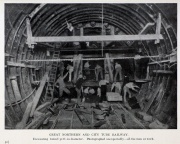Great Northern and City Railway
of 3 Highbury Place, London
The Great Northern & City Railway was first envisaged in 1891. The initial plan was to connect the GNR - just south of Finsbury Park - with Moorgate, in the City of London. Since the whole area was built up, the line was to be in deep tube but, unlike the other tubes, it was to be large enough to accommodate main-line coaches hauled by electric locomotives. As a result the tunnels were built 16 feet in diameter. [1]
1892 The company was incorporated to construct an underground electric railway between Finsbury Park on the Great Northern Railway and Moorgate Street in London. [2]
The GNR took an obvious interest in the project from the start, but as the GN&CR had more and more problems raising money, as disputes over the details of the agreement became worse, and as the GNR became involved with one of the predecessors of the Piccadilly Line, the situation changed from support to opposition. The GNR put onerous conditions on the use of Finsbury Park, gained Parliamentary powers to forbid extension north of the station, and eventually managed to get the line bottled up in a tube station underneath the mainline one (they ended up doing much the same with the Piccadilly Line).
1902 The company obtained power to extend the line from Moorgate Street to the Bank of England at Lothbury.
The line was eventually opened in 1904 - after the City and South London Railway but before the Charing Cross, Euston and Hampstead Railway. It was electrified from the outset, but with a power rail outside each running rail, 10 inches outside and 2 inches above the rail, supplied at 575 Volts DC. The generating station was situated on the Regents Canal just off the New North-road, at a point almost in the middle of the line. Four combined engines and dynamos were installed, made by Musgrave and Co. of Bolton.[3]
Powers existed to extend the route south about 450m to the Bank of England, but only a few metres were ever dug.
1913 While the line carried a reasonable traffic, it never made a profit, and was bought out by the Metropolitan Railway on 1st July. It was the only deep tube to have 1st class seating.
When they first acquired it, the Metropolitan considered extending the line to meet both the Waterloo and City at Bank and the Circle south of Moorgate. Later they simply planned the extension to run through Bank station to meet the Circle around Aldgate, but neither of these plans came to fruition.
A few years after the formation of London Passenger Transport Board in 1933, the line was transferred to the Northern Line for operational purposes, then being called the "Northern City Line". It was operated as part of the Northern Line, although it was never connected to it. This line was involved in the abortive Northern Heights Extensions project but otherwise remained unaffected for many years.
When the Victoria Line was built, the GN&CR services were cut back to Drayton Park, and the tube station at Finsbury Park was rebuilt to allow cross-platform interchange between the Victoria and Piccadilly. At the same time, a new northbound platform at Highbury and Islington allowed cross-platform transfers to the Victoria Line in both directions, the latter using the old northbound platform tunnel.
In March 1970 it was renamed again, to the "Northern Line - Highbury Branch".
Eventually London Underground closed the branch in 1975 and transferred ownership to British Rail, who installed new connections to the main line south of Finsbury Park and fitted overhead catenary as far as Drayton Park. Finally the route has taken on its original intended purpose of providing a City terminus for the (now ex-) GNR suburban services: WAGN (West Anglia Great Northern) EMUs now run from Moorgate to Hertford, Welwyn, and Letchworth, changing from 3rd rail to overhead power at Drayton Park.
1975 With the plans already in place for LU to give up the line, it then became the site of their worst-ever train accident (and fourth worst disaster). On 28 February, a tube train failed to brake approaching Moorgate and slammed into the blind tunnel at the south end of platform 9. The front half of the train crumpled up into the small space, killing 42 passengers and the driver. Investigation showed no mechanical failure, and the full reason for the crash has never been determined. However, as a direct result, new signalling was installed (known as "Moorgate control") to ensure that a train is stopped at dead ends such as Moorgate, whether or not the driver co-operates.


